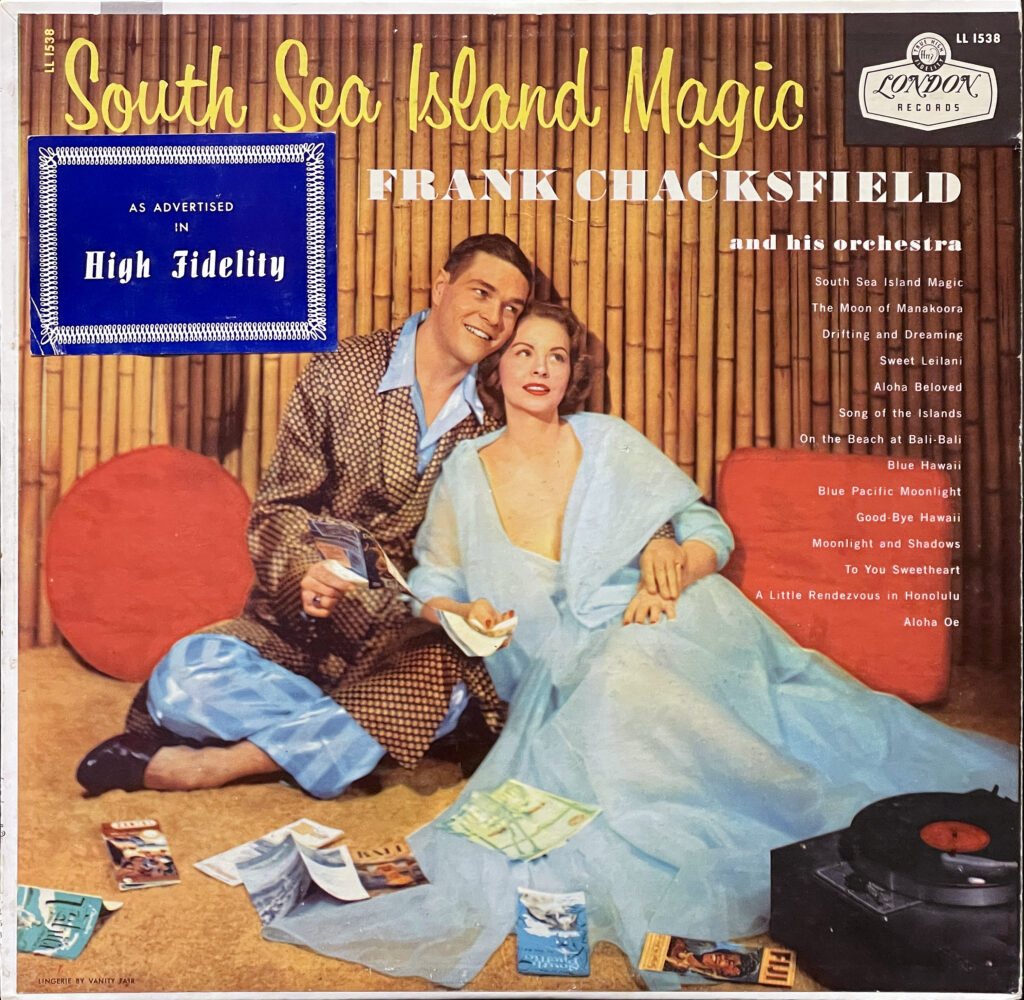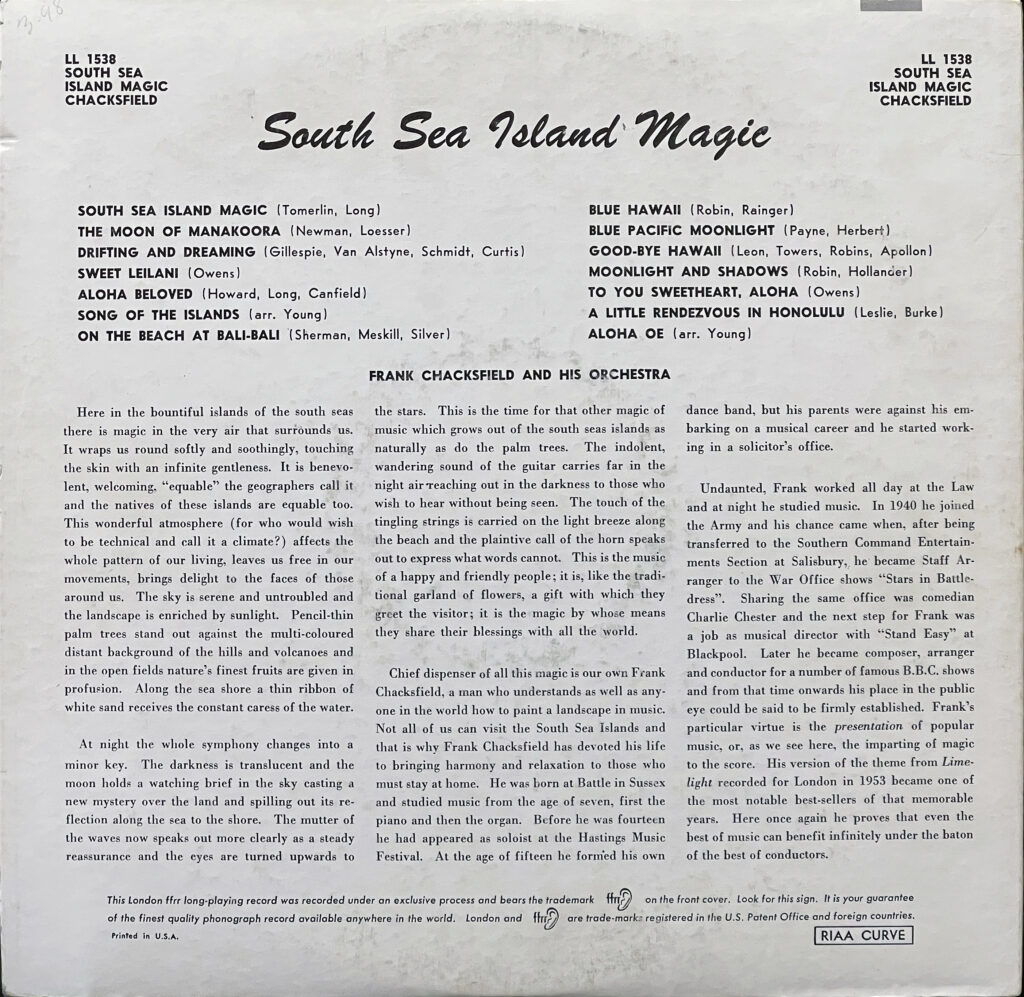Hey, fin-tastic folks! It’s your pal, Finnley the Dolphin, diving deep into the enchanting ocean of music to bring you something truly special today. On Finnley’s Audio Adventures, we explore the weirdest, wildest, and most wonderful soundscapes the audio world has to offer. And today, we’re setting sail to the melodious realms created by none other than Frank Chacksfield, a maestro who crafted waves of harmonies that still ripple through the sea. Join me as we embark on a journey to discover the timeless allure of “South Sea Island Magic,” an album that paints aural pictures of distant, serene landscapes. So, strap on your snorkels and let’s dive into this musical adventure!

Born on May 9, 1914, in the serene town of Battle, Sussex, England, Frank Chacksfield was destined to weave a tapestry of musical enchantment that would span decades. From an early age, Frank’s life was steeped in music; he honed his skills at the piano and organ, performing at local festivals and church services. By the age of fourteen, he was a soloist at the Hastings Music Festival, signaling the start of a luminous musical journey.
As a young man, Chacksfield’s talents continued to flourish, but he momentarily veered away from a full-time musical career, working in a solicitor’s office. The outbreak of World War II, however, steered him back towards his passion. Frank joined the Royal Corps of Signals and later, was transferred to the Southern Command Entertainment Section at Salisbury. There, he served as Staff Arranger to the War Office and collaborated with well-known comedian Charlie Chester. Post-war, Chacksfield’s career escalated as he became a musical director for various BBC radio shows, marking his ascent in the public eye.
Frank Chacksfield was not just another conductor; he was an orchestrator of atmospheres, a creator of musical landscapes that transcended the typical confines of easy listening and light orchestral music. By the time he formed “The Tunesmiths” in 1953, Chacksfield was well-prepared to infuse his deep understanding of orchestral dynamics into the popular music scene. His pioneering approach involved weaving complex string arrangements with a gentle touch, setting a benchmark for orchestral music that was both accessible and sophisticated.

Under Chacksfield’s baton, “The Tunesmiths” quickly became synonymous with innovation in orchestral music. This period marked a significant evolution in his career as he began to explore and solidify his style—an elegant blend of sweeping melodious strings and carefully calibrated dynamics. His music did not merely provide background ambiance but was crafted to engage and move his audience emotionally, bridging the gap between classical music’s formality and popular music’s approachability.
The albums released under his direction during the 1950s and 1960s showcased his flair for thematic and conceptual projects, which was relatively novel in the orchestral music scene at the time. Albums like “South Sea Island Magic” demonstrated his ability to create a cohesive auditory narrative that could transport listeners to other places and times. Chacksfield’s work was characterized by its lush arrangements and the seamless integration of different musical elements, which made his compositions stand out as masterful examples of orchestral storytelling.
Chacksfield’s contributions to the BBC and his extensive recording career with Decca Records further cemented his reputation as a leading figure in the world of easy listening. His ability to conduct large orchestras and manage complex arrangements made him a sought-after name in the music industry, leading to numerous radio broadcasts and television appearances. These platforms provided him with the opportunity to reach a broader audience, showcasing his unique talent and expanding his musical influence beyond the concert hall.
Throughout his career, Frank Chacksfield remained committed to the idea that orchestral music should not only be heard but also felt. His recordings continue to be celebrated for their depth, beauty, and precision, proving that his musical vision was not only ahead of its time but also timeless. As an orchestrator of both sound and emotion, Chacksfield’s legacy as an orchestral innovator endures, inspiring generations of musicians and listeners alike with his profound musical narratives.
During the late 1950s, as air travel began shrinking the globe and exotic destinations became more accessible to the masses, a genre of music known as “exotica” began to flourish. This genre, epitomized by artists like Martin Denny and Les Baxter, sought to evoke the mysterious allure of far-off lands through lush, often percussive soundscapes that featured unusual instruments and animal noises, creating an almost fantastical world of sound.
In this vibrant musical landscape, Frank Chacksfield’s album “South Sea Island Magic” stood out distinctly. Unlike the rhythm-heavy and sometimes bustling compositions typical of other exotica records of the time, Chacksfield opted for a more serene and orchestral approach. His album conveyed the tranquility of the South Seas not through jungle drums or the calls of wild animals, but through sweeping string arrangements and a gentle, melodious presentation.
“South Sea Island Magic” differed from its contemporaries primarily in its mood and instrumentation. While other exotica albums often leaned towards a more adventurous or mysterious tone, aiming to transport the listener to unexplored territories, Chacksfield’s compositions painted these remote landscapes as serene havens, ideal for relaxation and peaceful contemplation. His music didn’t just explore the physical aspects of these exotic locales but also captured their emotional and evocative essence, allowing listeners to feel the gentle breeze and hear the quiet lap of ocean waves through his orchestral interpretations.
This distinct approach did not rely on the novelty of the exotic as much as it embraced the beauty of the familiar, presenting it through an enchanting new perspective. While both styles of exotica shared the goal of auditory escapism, Chacksfield’s “South Sea Island Magic” invited listeners to drift peacefully on calm seas rather than embark on thrilling sonic adventures through dense jungles. Thus, the album carved out a unique niche in the realm of exotica music, appealing to those in search of a soothing, musical retreat to the islands of the imagination.
“South Sea Island Magic” was not only unique in its musical composition but also notable in its various releases, catering to an evolving audience’s listening preferences over years. Initially released in mono format by Decca in the UK (LK 4174, LK.4174) and New Zealand (LKM 4174, LKM.4174) in 1958, the album captured the essence of Chacksfield’s tranquil exotica through the standard audio technology of the time. The mono version laid the foundation for the album’s reception, emphasizing the lush orchestration and the cohesive flow of the musical journey.
As stereo recordings became more popular, offering a new dimension in sound experience, “South Sea Island Magic” was reissued in stereo on the Eclipse label (ECS 2002) in the UK in 1969. This release allowed listeners to experience a more immersive auditory scene, where the orchestral elements could be appreciated with greater depth and spatial awareness, enhancing the album’s escapist appeal.
The album’s reach extended beyond English-speaking audiences, as seen in its Spanish release titled “Las Mágicas Islas De Los Mares Del Sur” under the Decca and Eclipse labels (ECS 2002) in 1974. This version brought Chacksfield’s serene interpretations of the South Seas to a broader audience, emphasizing the universal appeal of his soothing musical landscapes.
These various releases not only highlight the enduring popularity of “South Sea Island Magic” but also reflect the shifts in music consumption preferences from mono to stereo, allowing Chacksfield’s tranquil exotica to be experienced in evolving audio formats. Each release, whether in mono or stereo, offered listeners a gateway to the calm and picturesque settings of distant islands, albeit through slightly different auditory perspectives.
Frank Chacksfield’s musical legacy is a testament to his profound impact on the world of easy listening and orchestral music. His compositions, which seamlessly blend classical music techniques with the accessibility of popular music, have left an indelible mark on the industry. His meticulous attention to orchestral detail and his ability to evoke vivid emotional landscapes through music continue to influence and inspire musicians and listeners alike.
Chacksfield was a pioneer in the orchestral pop genre, a style that harmoniously integrates traditional orchestral arrangements with popular music elements. His work helped lay the groundwork for future generations of musicians who seek to bring the richness of orchestral music to a broader audience. By demonstrating the versatility and expressive potential of an orchestra, Chacksfield opened the door for artists to experiment with and expand the boundaries of genre and form.
Beyond his recordings, Chacksfield’s approach to music has been studied in various academic and music circles for its innovative use of the orchestra in a pop music context. Music educators and students often analyze his arrangements to understand the integration of complex orchestral textures in accessible music formats. His ability to create lush, enveloping soundscapes has served as a blueprint for those looking to craft emotive and atmospheric compositions.
The preservation of Frank Chacksfield’s music through reissues and digital streaming platforms has introduced his works to new generations of listeners. This ongoing revival has not only cemented his status as a key figure in easy listening and light music but has also highlighted his role in shaping modern orchestral music. Various contemporary orchestras and easy listening music festivals frequently feature Chacksfield’s compositions, celebrating his contributions and keeping his musical spirit alive.
Chacksfield’s extensive discography, including over 50 albums, continues to be a significant part of classical and easy listening music collections around the world. His recordings are a treasure trove for audiophiles and collectors, prized for their historical value and their exquisite auditory experience. Furthermore, his work in broadcasting, particularly with the BBC, set high standards for musical programming and showcased how media could be used to extend the reach of orchestral music.
Frank Chacksfield’s legacy is not just in the notes he composed or the records he sold but in the emotional resonance his music continues to evoke. As an orchestral innovator, his influence resonates in the lush landscapes of sound he crafted, ensuring that his contributions to music will be appreciated for generations to come. Through his innovative spirit and timeless compositions, Chacksfield remains a beacon for those who aspire to blend the grandeur of orchestral music with the familiarity of popular melodies.
And the sun sets on another wonderful auditory adventure my sea-loving listeners—our audio voyage exploring Frank Chacksfield’s “South Sea Island Magic” comes to a gentle close. I hope this journey has left you feeling as refreshed as a cool breeze over the ocean. Chacksfield’s ability to weave tranquil tales through his music truly makes him a navigator of the orchestral seas, guiding us to shores of calm and beauty. Don’t forget, if you enjoyed today’s trip through musical waves, make sure to subscribe and hit that notification bell on my YouTube channel at https://www.youtube.com/@FinnleysAudioAdventures so you never miss an episode of Finnley’s Audio Adventures. Until next time, keep swimming in the sea of sounds, and remember, every tune tells a tale. Dive deep, explore more, and let the magic of music take you away!
Sources Used:
Discogs. “Frank Chacksfield And His Orchestra – South Sea Island Magic.” Available at: https://www.discogs.com/release/6192472-Frank-Chacksfield-And-His-Orchestra-South-Sea-Island-Magic
Clarke, Donald. “Music Encyclopedia: Frank Chacksfield.” Available at: http://www.donaldclarkemusicbox.com/encyclopedia/detail.php?s=940
The Robert Farnon Society. “Frank Chacksfield.” Available at: https://www.robertfarnonsociety.org.uk/index.php/legends/frank-chacksfield
Ryono, Marty. “Oldies Collection: Frank Chacksfield.” Available at: https://ryono.net/xtra/oldies/1953/frankchacksfield.htm
“Frank Chacksfield – A Retrospective.” (2017). Available at: http://btckstorage.blob.core.windows.net/site15733/Web%20N/N%20-%202017%20FRANK%20CHACKSFIELDv2%20(1).pdf
Jango. “Full Biography of Frank Chacksfield & His Orchestra.” Available at: https://www.jango.com/music/Frank+Chacksfield+His+Orchestra/_full_bio
Space Age Pop. “Frank Chacksfield.” Available at: https://www.spaceagepop.com/chacksfi.htm
Starborne Productions. “Music Directors: Frank Chacksfield.” Available at: https://www.starborne.net/music-directors/frank-chacksfield/
